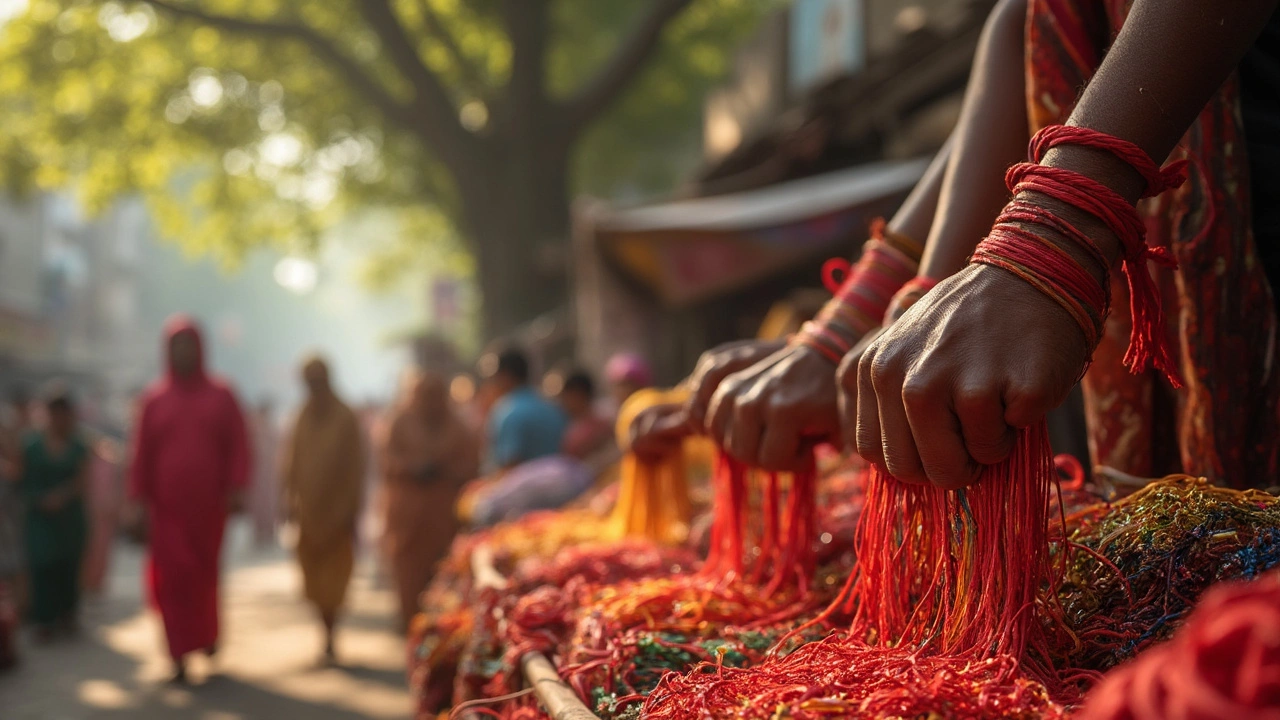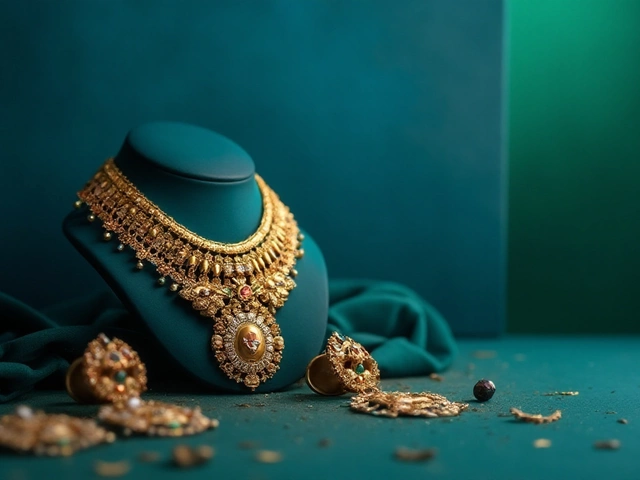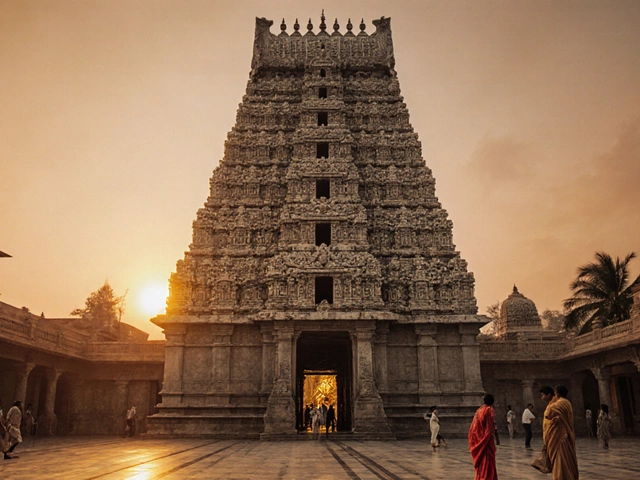
You might have noticed people in India wearing a red string tied around their wrist and wondered what it's all about. Well, it’s not just some fashion statement. This thin string, often worn on the left wrist by women and the right by men, is loaded with cultural oomph. It's called a 'Kalava' or 'Mouli' and is as much about tradition as it is about spirituality.
The roots of this practice go way back, with connections to Hindu rituals and beliefs. It's like a little reminder tied around the wrist, signifying protection, luck, and a conduit between the wearer and divine blessings. One intriguing thing is how it's used in various ceremonies, like during prayers or important life events. It’s like getting a spiritual hug to carry with you.
Now, the why and who of wearing it can vary from region to region. Some tie it during festivals or Puja (which is a form of worship) while others after visiting a temple. It’s a versatile little band that's all about positive vibes and spiritual safeguarding. So next time you see someone wearing it, you know they're carrying a piece of an age-old tradition that’s still going strong today.
- The Origin of the Red String
- Cultural and Religious Significance
- Who Wears It and Why
- Rituals and Ceremonies
- Modern Interpretations and Trends
The Origin of the Red String
Ever wonder how that simple red string found its way onto so many wrists in India? Its origins are a blend of culture, religion, and traditions that stretch back thousands of years. The red string is known as 'Kalava' or 'Mouli' in many parts of India, and it's more than just a decorative piece. It actually traces its roots to ancient Hindu texts where it served both religious and protective purposes.
Hindu scriptures, like the Puranas, mention the tying of a sacred thread as part of various rituals. During significant ceremonies like Yagya (a Vedic ritual of offerings accompanied by chanting of Vedic mantras), the priest would tie a sacred thread on the wrist of participants to signify protection and commitment. It was also believed to bring good fortune and ward off negative energy.
Traditionally, the wrist bracelet is tied during a Puja and is accompanied by blessings from the priest or elder. It's like a physical reminder of one's spiritual commitments and blessings received. The color red itself signifies passion, purity, and strength, which are all qualities the wearer is believed to embody or attract.
| Purpose of Red String | Significance |
|---|---|
| Protection | Wards off evil energies |
| Faith | Symbol of spiritual commitment |
| Fortune | Attracts good luck and prosperity |
This practice isn't confined to a specific group. While many Hindus follow it, you’ll also find variations among other communities, each attaching their own special meaning to it.
Cultural and Religious Significance
The red string isn't just a random accessory; it carries weight in both cultural and religious domains in India. At its core, it's a symbol of protection. Many believe that wearing this string wards off evil spirits and bad luck. It's like having a spiritual shield wrapped around your wrist, entrusted with the blessings of deities.
In Hinduism, the color red signifies purity, strength, and good fortune. It's pretty common to see this with other religious symbols too, like the red sindoor and bindi worn by married women. The string's presence is often proof of one's faith and dedication. During rituals or after performing a Puja, folks tie this wrist bracelet as a sign of sanctity and commitment.
What's really cool is how this practice is linked to various gods and goddesses. For example, it’s often associated with Lakshmi, the goddess of wealth, or Hanuman, the symbol of strength and protection. During Navaratri and other festivals, tying this string becomes part of the tradition, bringing in blessings for prosperity and courage.
It’s not just about protection; it builds a community vibe too. When you're part of an event and everyone gets a string tied, it creates a sense of unity and shared experience. It shows how individual beliefs connect to larger cultural narratives, a continuous thread through generations.
Despite its simple appearance, this Indian tradition packs a punch with its deeper meanings. It’s fascinating how something so small can hold decades of history, meaning, and faith in just a few strands of dyed cotton.

Who Wears It and Why
The red string bracelet isn’t worn by just anyone—it holds specific meaning for those who wear it. Primarily, it's popular among Hindus, though you might spot it in other religious communities in India too. The key idea here is protection. Every thread of this wrist bracelet is believed to bring good luck and shield the wearer from negative energy.
Let’s break it down. Men and women both wear the red string, but typically on different wrists. Men usually tie it on their right wrist while women often wear it on the left. Why? It's believed to channel positivity and safeguard the wearer's path in life. Seems pretty handy for something that's essentially just a piece of string!
If you're looking for occasions, well, there are loads! During Puja ceremonies, festivals like Raksha Bandhan or weddings, you'll see more strings tied than you can count. Priests often tie the red string when you’re taking part in a sacred ritual, sending you off with blessings and good vibes.
Children might wear it too, kind of like a spiritual insurance policy. For little ones, it’s a way parents can pass on blessings and protect them from the world’s harms. So when you see the red string, remember, it's not just decoration. It's a powerful symbol of faith and tradition, deeply woven into the lives of those wearing it.
Rituals and Ceremonies
Alright, so let’s get into the nitty-gritty of how the red string plays a role in all sorts of rituals and ceremonies. This seemingly simple thing can pop up in a bunch of different events, making each one feel a bit more special and significant.
For starters, we’ve got the traditional Hindu ceremonies, where the red string is tied during a Puja. This is like a supercharged prayer session where everyone seeks blessings from the gods. The string acts as a protective band, warding off bad vibes and inviting good luck. Often, a priest will bless it before tying it on your wrist, which is like getting a good luck charm customized just for you.
It’s also a common sight during weddings. Before the vows are exchanged, you might see the bride and groom getting the string tied either by a priest or their parents. It's meant to bring protection to the new couple, fostering unity and keeping troubles at bay. Think of it like a symbolic safety net for their new journey together.
Then there are other life events, like the thread ceremony, known as 'Upanayana', which is basically an initiation for young Hindu boys into spirituality and discipline. Here too, the red string plays a critical role, signifying protection and a reminder of their new spiritual responsibilities.
For those participating in a Havan, or fire ritual, the red string is an invitation to divine energy to surround the participants, sealing their intentions with a spiritual stamp. It’s like getting that mystical approval before you embark on any life endeavor.
Interestingly, it’s not just a Hindu thing. You’ll find folks from other religions in India using a red string during their rituals to bless and safeguard their journeys ahead. Whether tied personally or by a spiritual person, it's universally seen as a gesture of goodwill and blessing.

Modern Interpretations and Trends
These days, the red string on the wrist isn’t just about sticking to age-old beliefs. It's finding its way into modern fashion with a fresh twist. In recent years, this traditional bangle has been embraced by the younger crowd, adding a splash of contemporary flair while keeping those cultural vibes intact. It's like blending tradition with a dash of street style!
Many young Indians, especially those living abroad, wear the wrist bracelet as a symbol of identity and heritage. It’s become more of a personal statement, showing off one's roots with pride, wherever they might be. This has led to some creative adaptations, including wearing the string with added beads or charms that have personal significance.
What's even cooler is how various celebrities have been spotted rocking these wrist strings as a fashion statement. It’s not uncommon to see influencers pairing them with other accessories, making the red string a part of their signature style. This blend of style and tradition is making waves in fashion circles.
There's also been a growth in interest outside the Indian community. Some people wear it simply for the positive vibes it symbolizes while others are drawn to the spiritual connection it offers, tapping into broader mindfulness and wellness trends.
In short, the red string has been modernized yet still remains a powerful cultural symbol. Whether worn for protection, spirituality, or simply as a nod to one's heritage, it beautifully bridges the gap between past and present, tradition and trend.




